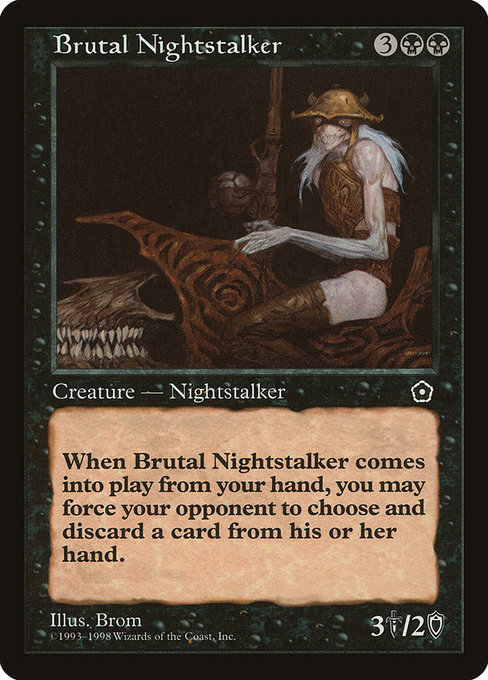
Image courtesy of Scryfall.com
Brutal Nightstalker and the online world of MTG lore
When you crack open a card from the Portal Second Age era, the flavor isn’t just printed text on cardboard; it’s a doorway into a web of fan-driven stories, theories, and shared moments across the internet. The tale of Brutal Nightstalker—a Creature — Nightstalker with a memorable, hands-on effect—offers a perfect lens for how communities form around card lore 🧙♂️. The card itself sits at the intersection of classic black resilience and old-school disrupt-with-style flavor, a relic from a 1998 print run that continues to spark conversations in forums, wikis, and streams. It’s a reminder that, long after the last rules text leaves the game, the stories fans tell around that text keep the magic alive 🔥.
What this card is telling us about Portal Second Age
Brutal Nightstalker costs {3}{B}{B} for a 3/2 creature, a respectable body for a black midrange drop from a starter set. Its key line—“When this creature enters, you may have target opponent discard a card”—is a compact snapshot of black’s evergreen philosophy: leverage disruption to seize tempo and momentum. In Portal Second Age, a set designed to introduce players to the basics of the game, that kind of effect feels both approachable and evocative. The art, by Brom, channels a moody, dungeon-corridor vibe that instantly communicates the nocturnal, stealthy nature of the Nightstalker. The set’s print run and rarity (uncommon) add a layer of collectible nostalgia that fans still chase through price guides and old-box openings, long after the cards left the showroom shelves 🧳💎.
Why lore-driven communities form around individual cards
Small moments on a card—an ETB trigger, a flavor line, a single piece of art—can ignite vast conversations across the internet. That spark is the heartbeat of MTG lore communities.
Online, fans gather in a tapestry of spaces that orbit around the lore, flavor, and history of MTG cards. Here’s how a card like Brutal Nightstalker becomes a talking point across communities:
- Descriptive lore threads on wikis and forums explore the imagined backstory of Nightstalkers from Dominaria-like shadows to modern-day battlegrounds, often riffing on the card’s ability to disrupt an opponent’s hand as a narrative motif of cunning and stealth 🕵️♀️.
- Flavor-first analysis on YouTube and podcasts dissect the Brom illustration, discussing how the artist’s brushwork and color palette conjure a particular era of MTG storytelling. The art isn’t just decoration—it’s a portal to reminiscence for players who learned the game during late-90s mornings and weekend games 🎨.
- Gameplay nostalgia threads in Reddit threads and Discord servers compare how old-school black cards shaped early deck-building heuristics, while fans ponder how a simple ETB discard ability could shift a single match or a casual kitchen-table duel ⚔️.
- Collector and price discourse around uncommon cards from Portal Second Age, often cross-referencing price data, availability, and print history on MTG-related marketplaces. Even modestly priced cards like Brutal Nightstalker become touchpoints for conversations about set design, rarity distribution, and the long tail of card collecting 🧭.
Where the conversations happen, and what they sound like
Across platforms, you’ll hear the same tempo: reverence for the era, curiosity about the card’s lore, and playful debates about how such cards would hold up in timeless formats. A typical thread might contrast how the Nightstalker’s ETB ability interacts with contemporary hand-disruption lines, question whether the art’s mood reflects a broader in-universe narrative, or simply celebrate Brom’s iconic fantasy style. The result is a multi-layered dialogue that blends rules talk, art appreciation, and speculative storytelling. In short, the internet’s MTG communities turn a single card into a living, breathing subculture 🧙♂️🔥.
Practical ways to engage with the lore ecosystem
If you want to dive in, here are accessible entry points that tend to be welcoming for newcomers and veterans alike:
- Gloss and flavor walkthroughs that map a card’s text to in-universe implications, often paired with gorgeous art thumbnails and historical context.
- Old-set showcases where fans compare Portal Second Age cards with later printings, noting design shifts and how these pieces influenced what came after.
- Collector blogs and market chats that trace price trajectories, supply quirks, and the sentimental value of uncommon staples from late-90s sets.
- Community Q&As and lore rounds hosted on Discord servers or community channels where people propose fan theories and test them against card texts and flavor lines.
As you wander these digital corners, remember that the joy of MTG lore isn’t just in the mechanics; it’s in the shared memory. The Nightstalker’s simple, efficient effect is a catalyst for narrative threads: the idea that a single blink of an eye or a single enemy card discarded can alter a moment in a game and, by extension, alter a story arc told around the table or online 🧭.
“The strongest stories in MTG aren’t just about winning; they’re about what we remember after the match ends—the card that sparked a hundred conversations.”
A nod to the card’s enduring place in the culture
Brutal Nightstalker stands as a reminder that lore in Magic is not limited to sprawling epic sagas. It thrives in the micro-moments—the way a card’s etb effect can prompt a memory, a debate, or a fan-made theory about who Nightstalker is and where they haunt the shadows. And as the broader MTG community continues to gather online—from seasoned MTG Wiki editors to fresh-faced Reddit newcomers—the card’s legacy grows in the margins between plays, art appreciation, and the endless hunt for that perfect vintage find. The story of MTG lore communities is as much about the people who discuss it as the cards that started the conversations 🧙♂️🎲.
While you’re exploring these forums and wikis, a small, casual upgrade for everyday life can complement the journey: protect the devices that carry your notes, theories, and game summaries. This is where a certain slim accessory fits in nicely—just like a well-timed discard, it’s unobtrusive, practical, and a little stylish in its own right.